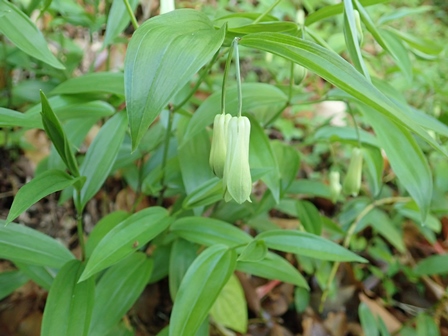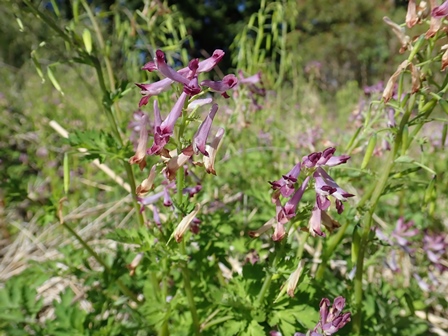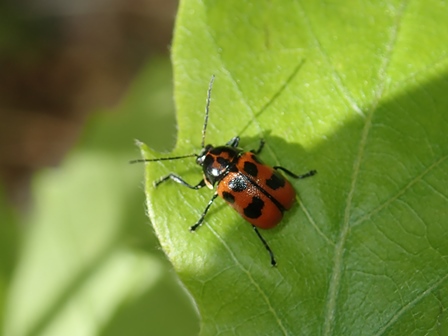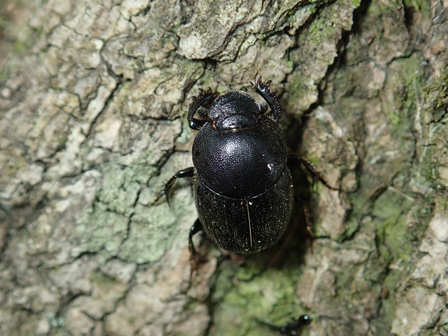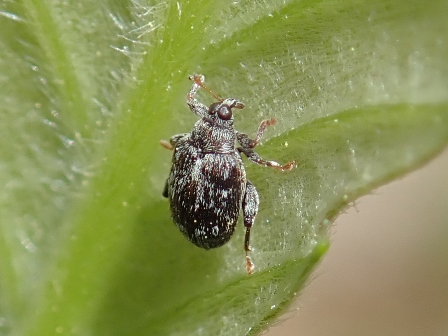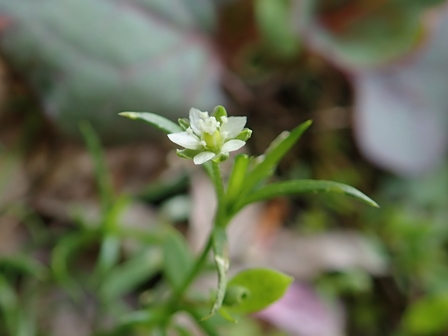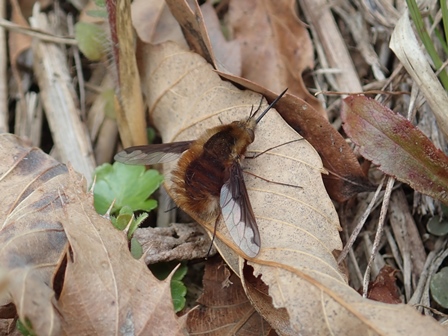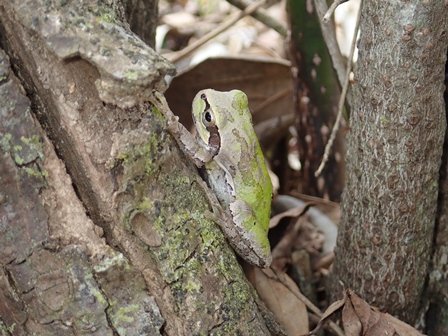フィールド日記
2021年04月
2021.04.30
ホウチャクソウ
校舎裏の斜面にホウチャクソウが咲いています。和名は、花の形が寺院に飾りとしてつるす宝鐸(ほうちゃく)と呼ばれる風鈴に似ていることに由来します。
"Houchaku-Sou (ホウチャクソウ)" plants are in bloom on the slope behind the school building. "Houchaku (ホウチャク)" in its name refers to the wind bells that are hung from the roof of temples as ornaments.
2021.04.27
ムラサキケマン
キャンプ場でムラサキケマンが咲いています。同じ仲間の中では最も普通で、道端や空き地などで見られます。花は、「距(きょ)」と呼ばれる花弁の一部が後方に袋状に突き出した構造を持っています。距の中には蜜が分泌されています。
"Murasaki-Keman (ムラサキケマン)" plants are in bloom in the campsite. They are the most common in the Kikeman group and grow along roadsides and vacant lands. Their flowers have a "spur", a backward bag-shaped feature that is a part of the petal sticking out. They produce nectar in the spur.
2021.04.23
クロボシツツハムシ
共生の森でクロボシツツハムを見つけました。コナラなどの広葉樹の葉を食べるハムシの仲間です。オレンジ色の体に黒い斑点があり、一見するとテントウムシのようです。多くの昆虫が、毒をもつテントウムシに擬態することで天敵から身を守っており、クロボシツツハムシもその1種と考えられます。
I found a "Kuroboshi-Tsutsuhamushi (クロボシツツハムシ)" in the Kyoseinomori-Forest (共生の森). They are leaf beetles that eat broad leaf trees such as Konara oak trees. They have black spots on their bright orange-base body so they look like a ladybug. Many insects mimic toxic ladybugs to protect themselves from their predators. "Kuroboshi-Tsutsuhamushi (クロボシツツハムシ)" is one of those insects.
2021.04.20
クサイチゴ
校舎の裏でクサイチゴの花が咲いています。背丈が低いため草と名前についていますが、木イチゴのなかまです。赤く熟した果実は食用になります。
"Kusa-Ichigo (クサイチゴ)" trees are in bloom in the backyeard of the school building. Though they are named "Kusa (クサ)", which means "weed", they don't grow tall. They are a wild raspberry and categorized as a woody plant. The red ripe fruits are edible.
2021.04.16
フトカドエンマコガネ
共生の森でフトカドエンマコガネを見つけました。食糞性コガネムシの一種です。今回は、古いシイタケのホダ木についていました。動物の糞だけでなく、腐ったキノコに集まることもあるようです。
I found "Futokado-Enmakogane (フトカドエンマコガネ)" in the Kyoseinomori-Forest (共生の森). They are a dung beetle. I found one on an old shiitake mushroom log. The beetles seem to gather not only on excrement but also on rotten mushrooms.
2021.04.13
ガロアノミゾウムシ
共生の森のコナラの葉の上で、ガロアノミゾウムシを見つけました。ノミゾウムシという名前の通り、2.5mmほどの小さいからだと、象の鼻のような長い口吻をもっています。幼虫は葉の内側に潜って生活しています(ガロアノミゾウムシの幼虫について記事はこちら)。
I found a weevil called "Garoa-Nomi-Zoumushi (ガロアノミゾウム)" on Konara oak leaf in the Kyoseinomori-Forest (共生の森). "Nomi (ノミ)" and "Zou (ゾウ)" mean "flea" and "elephant" respectively. They have a small body of about 2.5 mm in size and a long proboscis looking like elephant's nose. Their larvae live inside the leaves (Click here to read the article about the larvae of "Garoa-Nomi-Zoumushi").
2021.04.09
ツメクサ
キャンプ場でツメクサが咲いていました。道端や空き地でよく見られる1年草または越年草です。葉が細く、先がとがっており、鳥の爪に似ていることからツメクサ(爪草)と呼ばれています。
"Tsume-kusa (ツメクサ)" plants are in bloom in the campsite. They are an annual plant or a winter annual plant often seen in roadsides and vacant lands. "Tsume (ツメ)" in its name means "claws". Their narrow pointed leaves look like bird claws, so they are called "Tusme-kusa".
2021.04.06
ビロウドツリアブ
共生の森でたくさんのビロウドツリアブを見ることができます。春に見られるアブのなかまで、長い口吻で花の蜜を吸っています。ブーンという羽音を立てながら、羽を高速で動かし、ホバリングすることができます。まるで何かに吊るされているように、空中で静止している様子と、体にビロードのように毛が密に生えていることが和名の由来のようです。
I found many bee flies called "Biroudo-tsuriabu (ビロウドツリアブ)" in the Kyoseinomori-Forest (共生の森). They appear in spring and have a long proboscis to suck nectar. They move their wings quickly to hover making a bee-like noise. The name comes from their movement in the air and their hairy appearance like a velvet.
2021.04.02
ニホンアマガエル
共生の森でニホンアマガエルを見つけました。暖かい日が続き、冬眠から目覚めたようです。周囲の環境に合わせて体色を変化させることができ、地面の色に溶け込んでいました。
I found a frog called "Nihon-Amagaeru (ニホンアマガエル)" in the Kyoseinomori-Forest (共生の森). As we have had the warm weather for a few days, they seem to have waken up from hibernation. They change their body color adjusting to the environment, so the frog blends with the ground.
- 1 / 1


